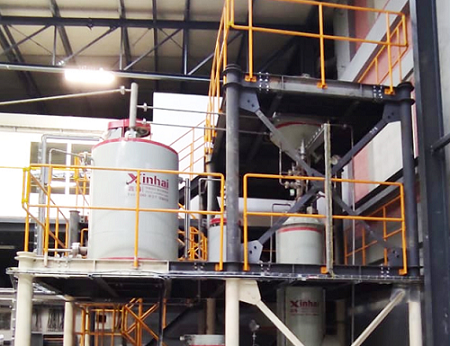How to beneficiate scheelite?
2025-03-24 Xinhai (1372)
2025-03-24 Xinhai (1372)
If you have any questions, please contact us through the following ways, we will give you more and better assistance!

As one of the important tungsten resources, the development of the beneficiation process of scheelite directly affects the utilisation efficiency and economic benefits of tungsten resources. With the gradual depletion of high-grade tungsten ore and the decline of ore quality, how to improve the beneficiation efficiency of low-grade and complex scheelite ore through technological innovation has become the focus of the industry. This paper will systematically describe the current situation and development of scheelite beneficiation process from the aspects of resource characteristics, traditional processes, emerging technologies and future trends.
The chemical composition of scheelite is calcium tungstate (CaWO₄), with moderate hardness and high density, which is usually endowed in the ore in the form of sarcoclastite type and quartz vein type. As scheelite is often coexisting with calcite, fluorite and other vein minerals, and tungsten elements are embedded in the form of microfine grains, its beneficiation process needs to take into account the mineral dissociation and efficient separation. Traditional beneficiation methods mainly include chemical separation and flotation. Chemical separation method is represented by hydrochloric acid decomposition method, which is highly efficient in decomposing scheelite through acidic conditions, and the decomposition rate can reach 99%, which has the advantages of short process and low cost, and is especially suitable for the treatment of low-grade ores. Caustic soda leaching method, soda solution pressure cooking method and fluorine salt decomposition method are important supplements to chemical sorting. Among them, fluorine salt decomposition method is considered as one of the most promising technologies at present due to the recycling of waste residue and purity of filtrate.

As the core process of scheelite selection, flotation method focuses on the efficient separation of scheelite and veinstone minerals. Through the synergistic effect of high temperature environment and sodium silicate, the heated flotation method (i.e. ‘Petrov method’) promotes the selective resolution of the trapper film on the surface of the minerals, so as to realise the preferential flotation of scheelite. Although the separation effect of this method is remarkable, the high temperature condition puts forward high requirements for equipment and operation safety. For this reason, room temperature flotation method has gradually become a research hot spot. Through the introduction of a combination of collectors, alkaline adjusters and new inhibitors, ambient flotation can reduce energy consumption while still maintaining high concentrate grade and recovery. For example, the combination process of water glass and trivalent iron ion activator can effectively inhibit the veinstone minerals and significantly improve the flotation efficiency of scheelite.
With technological progress, scheelite ore dressing process is constantly developing in the direction of refinement and greening. As an emerging flotation process, the lime method can achieve selective flotation of scheelite by adjusting the adsorption behaviour of Ca²⁺ in the slurry and changing the surface charge of calcite and fluorite, so that they generate precipitation and are inhibited. Tests have shown that the lime method was applied in a tungsten mine in Hunan province, and the concentrate grade and recovery rate both exceeded 70%. The fine-grained technology focuses on the sorting problems of micro-fine-grained minerals. Through hydrophobic agglomerate sorting technology, non-polar oil is used as a bridging medium to promote the aggregation of micro-fine-grained scheelite into agglomerates, which is then flotation to achieve high-efficiency separation. This technology shows a broad prospect in the field of low-grade ore and tailing resources.

Despite the maturity of the existing process, scheelite beneficiation still faces many challenges. For example, ores with high mud content easily lead to increased viscosity of the pulp, affecting the sorting effect; complex symbiotic ores in a variety of minerals with similar physical and chemical properties, increasing the difficulty of separation. In this regard, the industry is actively exploring composite process and intelligent sorting technology. For example, combining chemical sorting and flotation to form a ‘pre-decomposition - flotation’ joint process, which can further improve the recovery rate of low-grade ore. In addition, the application of automation control and big data analysis also provides the possibility of precise regulation of process parameters.
Environmental pressure is also driving the innovation of mineral processing. The traditional cyanidation method has been gradually eliminated due to toxicity, and replaced by the research and development of non-toxic or low-toxic chemicals. For example, the new biocapture agent selectively adsorbs minerals on the surface through microbial metabolites, which not only reduces environmental pollution, but also improves the sorting efficiency. Meanwhile, the promotion of wastewater recycling and tailings ecological restoration technology further reduces the impact of the beneficiation process on the ecological environment.
Looking ahead, the development of scheelite beneficiation process will be centred on the three themes of ‘high efficiency, green and intelligent’. On the one hand, through the integration of interdisciplinary technologies such as nanomaterials and genetic engineering, more selective agents and sorting methods will be developed; on the other hand, with the help of artificial intelligence and Internet of Things technology, intelligent beneficiation systems will be built to achieve real-time optimisation of process parameters and maximum utilisation of resources. Only through continuous innovation can we guarantee the sustainable supply of tungsten resources and promote the transformation of the mining industry to low-carbon and refined direction.